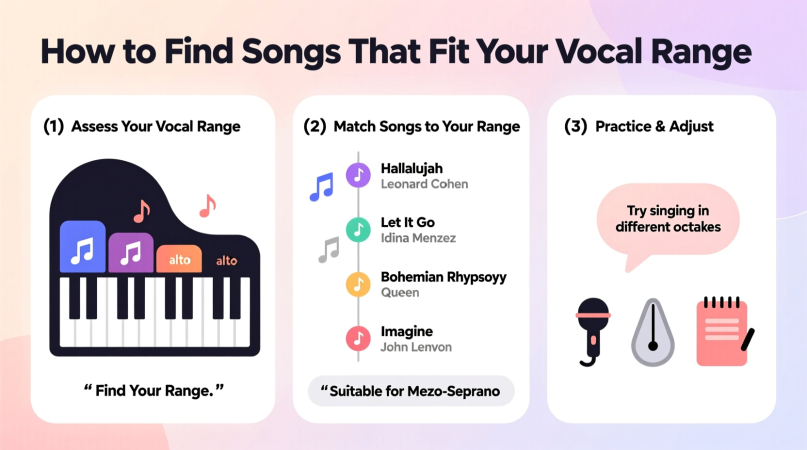
Singing a song that’s too high or too low can leave your voice feeling strained and your confidence shaken. The secret to choosing the right music is simple: pick songs that sit comfortably inside your vocal range. Here’s a step-by-step guide to help you match your voice to the songs that truly fit.
Step 1: Measure Your Vocal Range
Your vocal range is the distance between the lowest and highest notes you can sing clearly.
- Start by warming up with scales.
- Slide down to your lowest note and up to your highest.
- Write down the note names (for example, C3–G5).
👉 Not sure how to test accurately? Use our free Vocal Range Calculator to find your exact notes and voice type.
Step 2: Identify Your Voice Type
Most singers fall into one of six common categories:
| Voice Type | Typical Range | Examples |
|---|---|---|
| Soprano | C4–C6 | Ariana Grande, Mariah Carey |
| Mezzo-Soprano | A3–A5 | Adele, Lady Gaga |
| Alto/Contralto | F3–F5 | Amy Winehouse |
| Tenor | C3–B4 | Bruno Mars, Freddie Mercury |
| Baritone | G2–G4 | Elvis Presley, Ed Sheeran |
| Bass | E2–E4 | Johnny Cash |
Knowing your voice type helps you filter songs written for singers like you.
Step 3: Match Songs to Your Range
Now that you know your range and type, it’s time to find songs that fit.
- Check song range charts: Some sites and tools list the lowest and highest notes for popular songs.
- Search by vocal type: Try queries like “best pop songs for altos” or “tenor Broadway songs.”
- Use online tools: Input your range into tools that match songs to your notes.
Tip: Even if a song fits your range, pay attention to tessitura—the area where most of the song sits. A piece that hovers near your highest note will feel harder than one that stays mid-range.
Step 4: Adjust Songs to Fit Better
Don’t skip a favorite song just because the key feels too high or low.
- Transpose: Shift the key down or up to match your comfort zone.
- Try acoustic or live versions: Artists often perform in easier keys on stage.
- Switch octaves: Singing certain phrases an octave lower or higher keeps the song accessible without losing its impact.
Step 5: Example Songs by Range
Here are a few songs with known ranges to get you started:
- “Someone Like You” (Adele) – A3–E5 (mezzo-soprano friendly)
- “Just the Way You Are” (Bruno Mars) – Bb2–D5 (good for tenors)
- “Hallelujah” (Leonard Cohen/Jeff Buckley) – C3–C5 (baritone/tenor adaptable)
- “Halo” (Beyoncé) – A3–F#5 (suits sopranos and mezzo-sopranos)
FAQs: Finding Songs That Match Your Voice
How do I know if a song is too high or low for me?
If you feel tension in your throat or can’t sustain the notes clearly, it’s outside your comfortable range.
Can I sing songs outside my range?
Yes—if you transpose or adjust. But forcing your voice can cause strain.
What’s more important: range or tessitura?
Tessitura often matters more. A song that sits in your sweet spot will feel effortless, even if the extremes look easy on paper.
Do I need music theory knowledge to figure this out?
Not at all. Tools like our Vocal Range Calculator make it simple.
